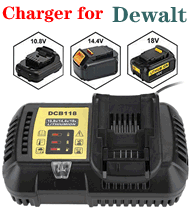Cordless Drill Batteries
- Bosch Cordless Drill Battery
- Makita Power Tool Batteries
- Dewalt Power Tool Battery
- Milwaukee Cordless Drill Battery
- Dyson Vacuum Cleaner Battery
- Ryobi Power Tool Battery
- Panasonic Cordless Tool Battery
- Black & Decker Drill Batteries
- Paslode Power Tool Battery
- Hitachi Cordless Drill Batteries
- AEG Power Tool Batteries
- Metabo Drill Batteries
- Worx Power Tool Battery
- Irobot Vacuum Batteries
- Dremel Cordless Drill Battery
- Drill Battery Charger
Top Sale Drill Batteries
How to Charge and Store Power Tool Batteries
Charging
Power tools batteries lose strength gradually and then become obsolete over time. It happens with age and too much usage.
However, before the inevitable happens, there are several things you can do for your battery; by caring for it and prolonging the time it serves you.
To care for, and maintain these batteries so that they serve you well, these are the things to consider:
- Allow for consistent use. This means that you discharge your power tool as often as required. This then allows the battery to perform the work it was meant to do without being left to sit idle. By so doing, the battery's electrons are active.
- Avoid partial charging. To keep your Milwaukee tool battery as healthy as possible, ensure that it always charges until full capacity. The best thing about full charge is that it also gives you a longer run time, than if you just give it an incomplete charge. This especially applies to NiCd and NiMH. Li-ion allows for partial charges which do not harm the battery at all.
- Keep your battery cool and dry. This serves to protect it from overheating and hard shocks. Some of these batteries are quite sensitive to temperature. For instance, if you are using Li-ion, then you have to be very careful of extreme temperature they can easily overheat. At the same time, keep the batteries away any kind of wetness and cold or wet surfaces. The drier your battery remains, the better for its cycle life and durability.
- Avoid deep discharge for your battery. Always be on the lookout to notice if your power tool is showing any signs of weakening in its power. If that is the case, you can quickly charge it; alternatively, you can use a second charge battery to jump-start it. Ensure that the battery drains completely instead of running it down.
- Utilize variable power settings on your power tool. For instance, if you have the option for lower settings on your power tool, using them could make your power tool to function for a long time than if you were applying the faster or medium mode.
- Avoid overcharging your Dyson vacuum cleaner battery. Overcharging has a way of damaging and shortening the cycle life of your battery. To keep it as healthy and working well as possible, remove it from the charge once it has charged to full capacity. This will help you retain it for as long as possible.
Storing
In normal circumstances, batteries are created to be consistently in use. The best way to keep a battery in good condition, therefore, is to let it be in use as much as possible.
But sometimes this is not always possible, and the battery has to be kept inactive. If you are keeping your power tools in an inactive mode, and your battery as well, there are ways to store it.
- Is your project very power-hungry?, possibly at room temperature to keep your battery.
- Place your battery in the original plastic case in which it came; once you have done that, place it gently in a box or wrap it in a soft cloth.
- If you are storing your Li-ion batteries, ensure that they are just partially charged and not fully charged. They should also just be partially discharged, not fully discharged. The same method can be used for the Nickel batteries. Either way, go by what the manufacturers have instructed on how to store your battery.
- After a long period of storage for your Nickel batteries, ensure that you recharge them once more before you start using. This is because, upon storage, they drain quite fast; and by the time you awaken them, they virtually have no charge in them.
- As for Li-ion, once correctly stored as per instructions, you are bound to start using them without charging as they would still have retained their power.
- If you have a freezer or refrigerator in the vicinity, be careful not to leave your Ryobi drill battery on them. Damage can easily occur because of the cold temperatures which can affect your battery.


Manufacturers' names and models are used for reference purposes only. Prices subject to change. Errors and omissions excepted. Contact centres may be monitored or recorded. © 2010-2025 All rights reserved.

